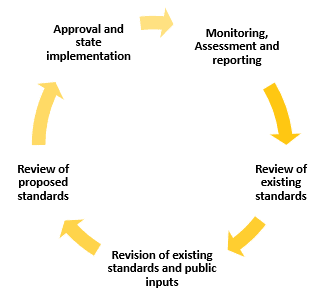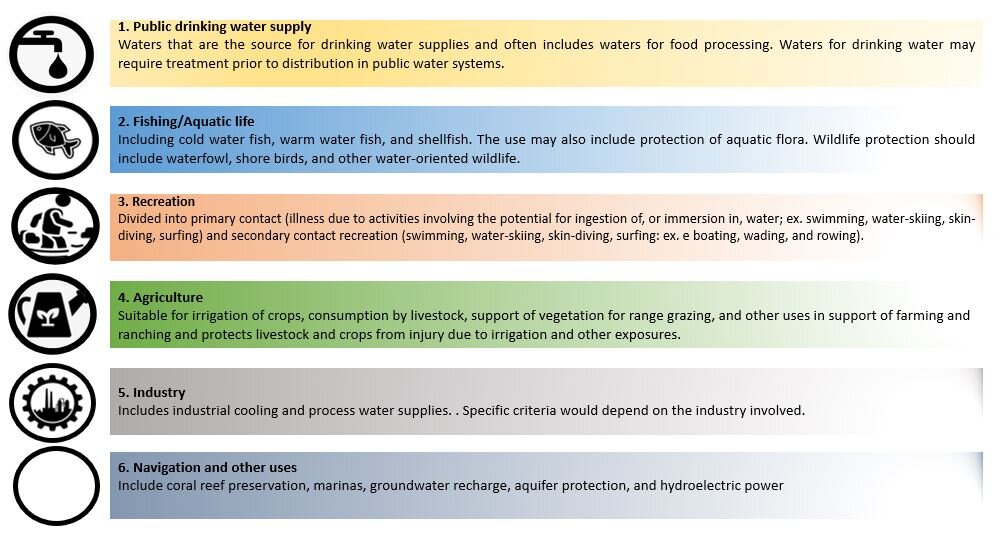Knowledge Hub
Water quality standards
What are water quality standards?
Water quality depends on the intended use of water which may be human consumption, industries, agriculture, etc. According to proposed use of water, quality criteria are established. Based on these criteria, quality standards are specified by health and other agencies.
To protect public health and environment, and to maintain a standard of water quality consistent with its designated users
How are water quality standards developed?
Each state has its own procedures for adopting water quality standards. standards are developed using a work group process with scientifically-defensible methods to develop their own criteria and are proposed for public comment

Components of water quality standards?

Water quality criteria represent the conditions (e.g., concentrations of particular chemicals, levels of certain parameters) sufficient to restore and maintain the chemical, physical, and biological integrity of water bodies and protect applicable designated uses.
1. Numeric - Establish thresholds for the physical, chemical and biological attributes required to support a beneficial use
 e.g., the maximum pollutant concentration permitted in a water body levels
e.g., the maximum pollutant concentration permitted in a water body levels
Water quality criteria represent the conditions (e.g., concentrations of particular chemicals, levels of certain parameters) sufficient to restore and maintain the chemical, physical, and biological integrity of water bodies and protect applicable designated uses.
2. Narrative - Describe rather than quantify, conditions that must be maintained to support a designated use
 e.g., a criterion that describes the desired conditions of a water body being “free from” certain negative conditions
e.g., a criterion that describes the desired conditions of a water body being “free from” certain negative conditions
Country required to develop rules and implementation procedures. The antidegradation policy provides the goals and framework and protection
- To protect existing uses
- To prevent clean waters from degraded, unless the action responsible for deterioration provides a social or economic benefit
Types of water quality standards
For Protection of public health
The Guidelines for Drinking-water Quality (GDWQ) are normative publications of the World Health Organization (WHO). They are addressed to water and health regulators, policy-makers and their advisors, mainly to assist them in the development of national standards. The GDWQ include an assessment of the health risks presented by the various microbial, chemical, radiological and physical contaminants that may be present in drinking-water.
| WHO drinking water quality guidelines |
View
|
|---|---|
| Sri Lankan drinking water quality guideline | |
| Guidelines for drinking water quality 4th edition |
Bottled (packaged) drinking water; Water which is used for human consumption and may contain naturally occurring minerals, carbon dioxide, but shall not contain added sugars, sweeteners, flavoring substances or other food ingredients or additives
General Requirements
The product shall not exceed the guideline values specified in latest edition of WHO Guidelines for drinking water quality, agrochemicals and pesticide residues
| Sri Lankan Requirements |
View
|
|---|---|
| DRAFT STAINDARD FOR PUBLIC COMMENT |
| Tolerance Limits for the Discharge of Industrial Waste Water into Inland Surface Waters | |
|---|---|
| Tolerance Limits for Industrial Waste Water Discharged on Land for Irrigation purpose | |
| Tolerance Limits for Industrial and Domestic Waste Water Discharged into Marine Coastal Areas | |
| Tolerance Limits for Waste Water from Rubber factories being Discharged into Inland Surface Waters |
View
|
| Tolerance Limits for Waste Water from Textile Industries being Discharged into Inland Surface Waters | |
| Tolerance Limits for Waste Water from being Discharged from Tanning Industries |